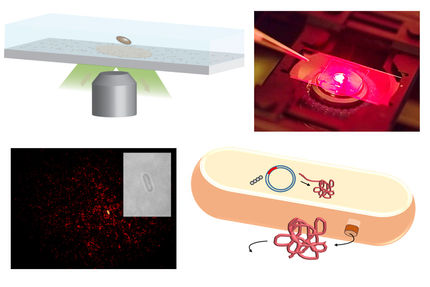Revolutionary nanotechnology illuminates brain cells at work
Until now it has been impossible to accurately measure the levels of important chemicals in living brain cells in real time and at the level of a single cell. Scientists at the Carnegie Institution's Department of Plant biology and Stanford University are the first to overcome this obstacle by successfully applying genetic nanotechnology using molecular sensors to view changes in brain chemical levels. The sensors alter their 3-dimensional form upon binding with the chemical, which is then visible via a process known as fluorescence resonance energy transfer, or FRET. In a new study, the nanosensors were introduced into nerve cells to measure the release of the neurotransmitter glutamate--the major brain chemical that increases nerve-cell activity in mammalian brains. It is involved in everything from learning and memory to mood and perception. Too much glutamate is believed to contribute to conditions such as Alzheimer's and Parkinson's disease. The research is published in the May 30-June 3 on-line early edition of the Proceedings of the National Academy of Sciences.
"The fluorescent imaging technique allows us to see living cells do their jobs live and in color," explained Sakiko Okumoto, lead author of the study at Carnegie. "Understanding when and how glutamate is produced, secreted, reabsorbed, and metabolized in individual brain cells, in real time, will help researchers better understand disease processes and construct new drugs."
"FRET is like two musical tuning forks, which have the same tone," Okumoto continued. "If you excite one, it gives a characteristic tone. If you bring the second fork close to the first one, it will also start to give you a tone even though they do not touch. This is resonance energy transfer."
FRET is used to track the form of proteins that specifically bind metabolites such as sugars and amino acids. A protein of interest is genetically fused with two differently colored tags made from variants of the jellyfish Green Fluorescent Protein (GFP). The colored tags are placed at each end of the molecule making a "biosensor." When the substance of interest binds to the sensor, the sensor backbone becomes reoriented, and the reorientation can be detected. Since light is a vibration, the same response occurs with two fluorescent dyes that have overlapping, but slightly different colors-in this case cyan and yellow versions of GFP. The cyan is excited and, if the distance between the colored proteins changes, more or less energy is transferred to the yellow protein. In this study, the cyan and yellow proteins behave as if they move away from one another when the sensor recognizes glutamate. Thus, there is more cyan and less yellow light than in the absence of glutamate. The sensors are encoded by genes and genetic ZIP codes can be used to target the sensors to any location in the cell and to its surface.
"We used a protein called ybeJ from the common bacterium E. coli. We first predicted the structure of this protein, and then placed the two fluorophores at specific positions on the binding protein," commented co-author Loren Looger. "After fusion to the fluorescent proteins, we placed the sensor on the surface of rat hippocampal cells. The hippocampus is the part of the brain that is involved with emotional reactions, and it helps store learned information in memory. When neurons are activated, they secrete glutamate, and we could see this activity under the microscope by watching the color change. We stimulated the neurons and watched them secrete glutamate in response. We also saw the removal of the glutamate as the neurons returned to normal ready to fire again."
"This is a tremendously exciting technology," remarked Wolf Frommer, leader of the FRET team at Carnegie. "I'm anxious to see what we can learn about the vast complexities of the brain over the coming years, such as the role of glial cells in the process of glutamate removal from the synaptic cleft. It's fascinating to see a tool that we are using in plant biology open new areas in neuroscience."
Most read news
Topics
Organizations
Other news from the department science
These products might interest you

Kjel- / Dist Line by Büchi
Kjel- and Dist Line - steam distillation and Kjeldahl applications
Maximum accuracy and performance for your steam distillation and Kjeldahl applications

AZURA Purifier + LH 2.1 by KNAUER
Preparative Liquid Chromatography - New platform for more throughput
Save time and improve reproducibility during purification

Get the analytics and lab tech industry in your inbox
By submitting this form you agree that LUMITOS AG will send you the newsletter(s) selected above by email. Your data will not be passed on to third parties. Your data will be stored and processed in accordance with our data protection regulations. LUMITOS may contact you by email for the purpose of advertising or market and opinion surveys. You can revoke your consent at any time without giving reasons to LUMITOS AG, Ernst-Augustin-Str. 2, 12489 Berlin, Germany or by e-mail at revoke@lumitos.com with effect for the future. In addition, each email contains a link to unsubscribe from the corresponding newsletter.

























































